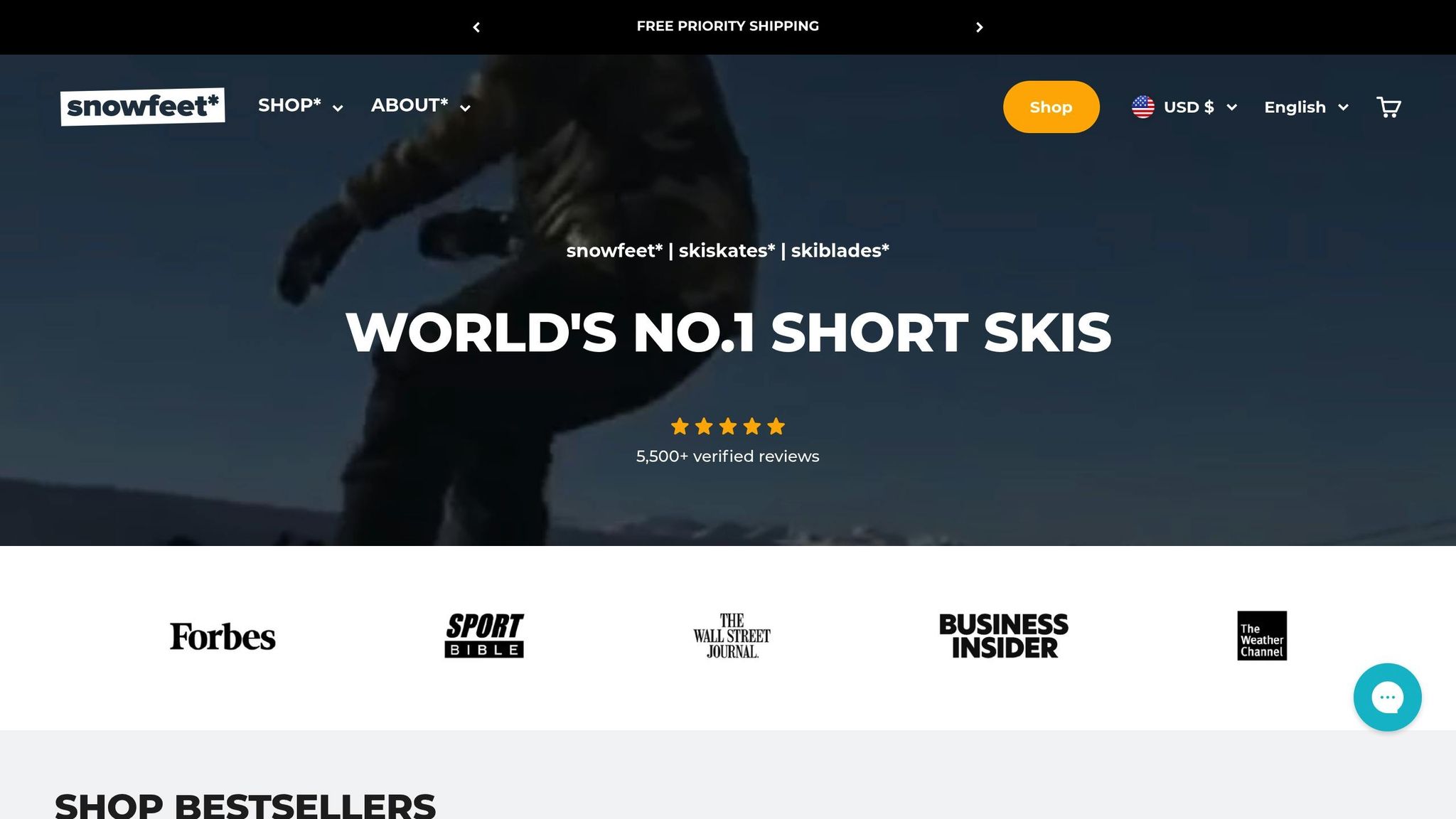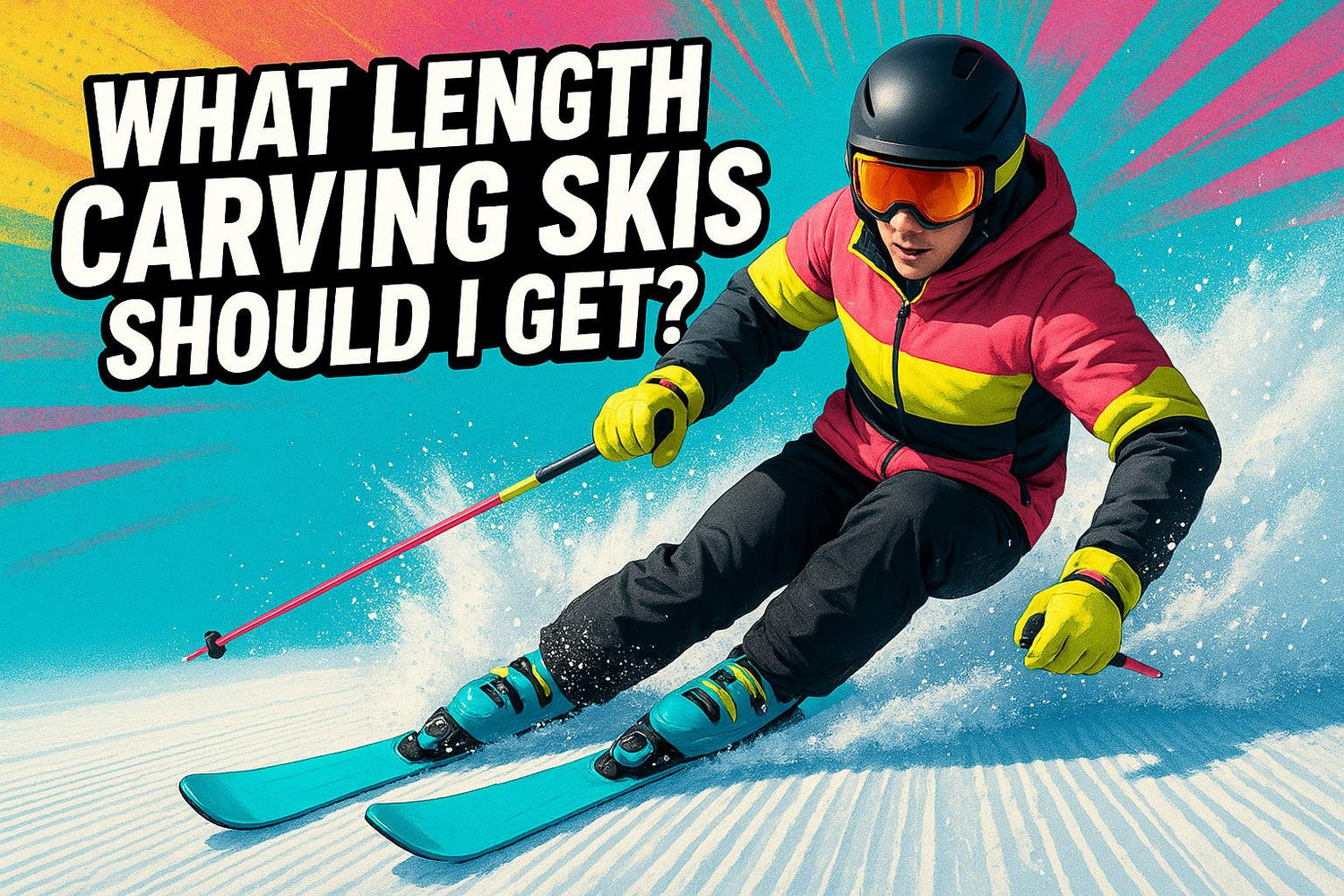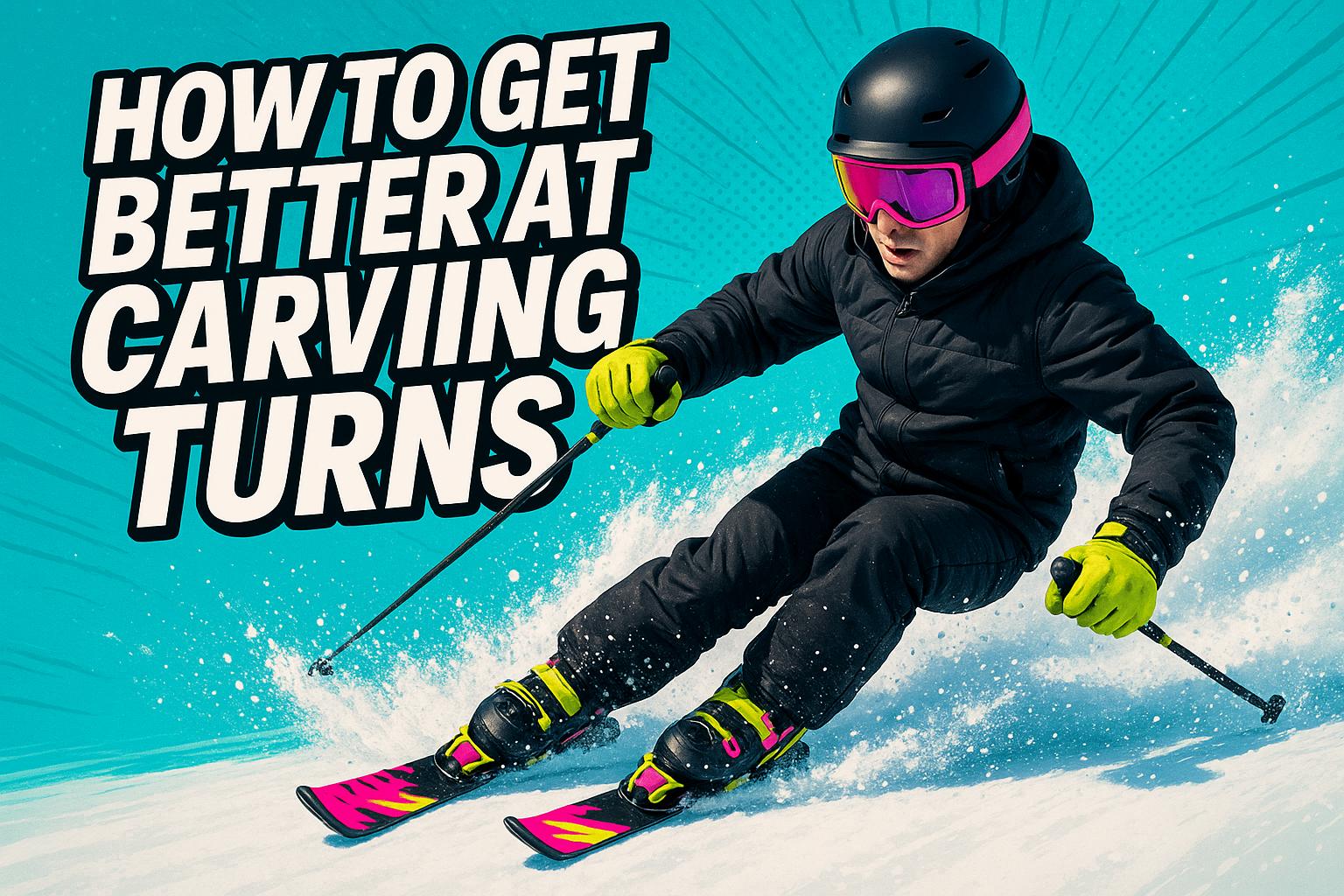If you’re wondering what length carving skis to get, here’s the quick answer: shorter skis are easier to control and better for tight turns, while longer skis provide more stability at high speeds.
For most recreational skiers, shorter skis - like Snowfeet’s Skiblades (65 cm, 99 cm, or 120 cm) or Skiskates (44 cm) - offer better maneuverability and a playful feel, making them ideal for groomed runs and crowded slopes. On the flip side, longer carving skis from brands like Rossignol or Atomic (150 cm to 200 cm) shine on wide-open runs, offering smoother rides at higher speeds but requiring more effort to turn.
Key Points:
- Shorter skis (under 100 cm): Great for beginners, easy to transport, and perfect for quick turns.
- Longer skis (170–190 cm): Better for speed and stability but harder to maneuver in tight spaces.
- Skill Level: Short skis suit beginners and intermediates; longer skis cater to advanced skiers.
- Price: Short skis start around $150, while longer skis can cost $300 to $1,200+.
If you prioritize control, portability, and fun, go short. If speed and stability are your goals, stick with longer skis. Either way, pick what matches your style and the slopes you love. :)
Carving ski guide - Picking piste skis for carving the slopes | SkatePro.com

1. Snowfeet* Short Skis (Skiblades and Skiskates)

Snowfeet* brings a fresh twist to carving skis with their compact and nimble designs. Their lineup includes Skiblades in 65 cm, 99 cm, and 120 cm lengths, alongside the ultra-compact 44 cm Skiskates. These aren’t just mini versions of traditional skis - they’re crafted to prioritize agility and precision.
Maneuverability
The shorter length of Snowfeet* skis completely changes how you tackle groomed runs. Take the 65 cm Skiblades, for example - they allow for quick, smooth transitions between turns, making them far less effort-intensive than longer skis. The 44 cm Skiskates take things a step further, reacting instantly to even the slightest weight shifts. This quick responsiveness is a game-changer, especially on crowded slopes where fast adjustments are key. Even the 120 cm option strikes a balance, providing the playful feel of shorter skis while still offering enough length for stability during wider, sweeping turns. This level of maneuverability not only makes skiing more intuitive but also helps skiers refine their technique with ease.
Control and Learning Curve
Short skis like Snowfeet* simplify the learning process by making turns easier to initiate. Unlike traditional long skis, which require more effort to engage edges, these shorter models respond effortlessly, keeping your center of gravity closer and improving balance. This makes them ideal for beginners looking to build confidence. For advanced skiers, the immediate feedback from these skis allows for fine-tuning carving angles and edge pressure, helping to perfect technique with precision.
Portability
One of the standout features of Snowfeet* products is how portable they are compared to traditional skis. Skiblades, for instance, are far easier to transport. While traditional skis often call for oversized bags and larger vehicles - think UberXLs or SUVs - Snowfeet* skis can fit right into a backpack. Their compact, lightweight design is a dream for anyone trying to pack light for a ski trip. Beyond the slopes, their portability opens up opportunities for use on hiking trails and sledding hills, making them incredibly versatile.
Stability at High Speeds
When it comes to high-speed skiing, Snowfeet* short skis trade straight-line stability for agility. Long skis from brands like Atomic or Rossignol are designed to handle high speeds with extended edges that provide extra stability. Snowfeet*, on the other hand, focuses on quick response and control, which is perfect for recreational skiers who stick to moderate speeds. This trade-off ensures a safer, more enjoyable experience by keeping your focus on control and technique rather than sheer speed.
2. Traditional Carving Skis (Rossignol, Atomic, Elan, Head, etc.)

When it comes to skiing on groomed slopes, traditional carving skis from brands like Rossignol, Atomic, Elan, and Head have been the go-to choice for years. These skis typically range from 150 cm to over 200 cm in length, catering to skiers of varying skill levels and preferences. Unlike the compact, nimble design of Snowfeet*, traditional skis prioritize high-speed stability, offering a very different experience on the slopes.
Maneuverability
Traditional carving skis, with lengths often between 170 cm and 190 cm for most recreational skiers, require more effort to initiate turns compared to shorter skis. They shine on wide, open runs where their stability and smooth carving can be fully appreciated. However, their length can be a disadvantage in tight or crowded areas, making quick, sharp turns more challenging. On busy or narrow slopes, the agility of shorter skis becomes a clear advantage. For beginners and intermediates, this reduced maneuverability can make learning and controlling turns a bit trickier.
Control and Learning Curve
For those new to skiing or still building their skills, traditional carving skis come with a steeper learning curve. Their longer length means that initiating turns requires more precision and proper technique. Some manufacturers address this challenge by offering beginner-friendly models, often called "easy carvers." These skis feature softer flex patterns and pronounced waists, making it easier to turn and forgiving minor mistakes. Still, mastering traditional skis generally takes more time and patience compared to shorter or more agile options.
Stability at High Speeds
Where traditional carving skis truly stand out is in their stability at high speeds. Thanks to their subtle sidecuts and extended edges, these skis are built for long, sweeping turns on groomed runs. The longer turn radii created by the sidecuts enhance stability, making them a favorite for advanced skiers seeking smooth, controlled descents at speed. However, this focus on stability comes at the cost of quick responsiveness, which might be missed by recreational skiers who prefer more dynamic movements on the slopes.
sbb-itb-17ade95
Pros and Cons
When deciding between Snowfeet* short skis and traditional carving skis for groomed slopes, it’s crucial to weigh the benefits and drawbacks of each. Your choice will depend on your skiing style, experience, and what you want out of your time on the mountain. Let’s break it down:
| Feature | Snowfeet* Short Skis | Traditional Carving Skis |
|---|---|---|
| Control & Learning | Easier to handle and great for beginners | Require more precision and advanced technique |
| Maneuverability | Highly agile, perfect for tight spaces and quick turns | Better suited for wide, open runs but less nimble |
| Portability | Super compact (44–120 cm) and light enough to fit in a backpack | Larger (170–190 cm) and need ski bags or roof racks |
| Speed Stability | Stable at moderate speeds but less so at higher speeds | Excellent stability even at high speeds and on tough terrain |
| Fun Factor | Playful and great for quick turns and tricks | Offers a smooth, grounded carving experience |
| Price Range | Around $150–$690, depending on the model | Typically $300 to over $1,200 for premium brands |
| Skill Level | Perfect for beginners and intermediates | Geared more toward advanced and expert skiers |
Snowfeet* short skis clearly shine in certain areas. They’re incredibly portable - small enough to fit into a standard backpack or even carry-on luggage. Compare that to traditional skis from brands like Rossignol, Atomic, or Head, which usually require bulky bags or roof racks. This portability makes Snowfeet* a hassle-free option, especially for casual skiers who want to skip the logistics headaches.
On the other hand, traditional carving skis dominate when it comes to stability and speed, especially on open runs. However, they come with a steeper learning curve and often a heftier price tag.
If you’re someone who hits the slopes occasionally and wants an easy, fun, and low-maintenance experience, Snowfeet* short skis are a fantastic choice. They’re playful, beginner-friendly, and won’t weigh you down - literally or figuratively. For those who prefer the classic feel and performance of carving skis, though, the investment and effort might be worth it. Either way, the choice depends on what kind of skiing experience you’re after.
Conclusion
Snowfeet* short skis stand out as a top choice for skiers aiming to get the most out of groomed slopes. Their compact design offers unmatched maneuverability, an easier learning process, and incredible portability, making your time on the mountain more enjoyable.
These skis cater to a wide range of skill levels. For beginners and intermediates, Snowfeet* models are forgiving and playful, helping to build confidence and improve skills at a faster pace. They're perfect for those just starting out or looking to refine their technique.
Experienced skiers aren't left out either. The 99 cm and 120 cm models deliver quick, precise performance that advanced users will appreciate, especially when navigating tight turns or varied terrain.
With prices ranging from $150 to $690, they’re also a budget-friendly alternative to many high-end traditional skis, offering great value without sacrificing quality.
FAQs
How do Snowfeet short skis compare to traditional carving skis for beginners and skill development?
Snowfeet short skis are crafted to make skiing simpler and more fun, especially for beginners. Their compact design means better control, easier balance, and smoother turns, which can really help new skiers gain confidence and improve their skills faster. Unlike traditional carving skis from brands like Rossignol or Atomic - usually longer and trickier to master - Snowfeet's shorter length feels less intimidating and is much quicker to pick up.
These short skis are also more forgiving on groomed slopes, making them a great option for anyone wanting to improve without the steep learning curve that comes with longer skis. Whether you're just starting out or hoping to fine-tune your technique, Snowfeet provides an enjoyable and effective way to level up on the slopes.
Are Snowfeet short skis a good option for advanced skiers who want stability at high speeds on groomed runs?
Snowfeet short skis, like the Skiblades (65–120 cm), are all about agility, portability, and pure fun. They’re a great pick for casual and recreational skiers who want a playful and easy-to-handle option. Thanks to their shorter length, these skis offer impressive control and let you make quick turns effortlessly. However, keep in mind that their compact size means they’re not as stable at high speeds as traditional long skis.
For advanced skiers chasing high-speed performance or superior edge grip on icy or hard-packed groomers, longer skis from brands like Rossignol, Atomic, or Head might be a better fit. But if you’re in it for the quick maneuvers, lightweight design, and a skiing experience that’s easy to transport and downright fun, Snowfeet short skis are tough to beat!
Why are Snowfeet short skis the best choice for portability and versatility on a ski trip?
Snowfeet short skis are a game-changer for ski trips, thanks to their super portable design and all-around usability. Measuring just 44 cm to 120 cm, these skis are incredibly compact, making them easy to toss in your bag or carry without the need for bulky ski racks or oversized luggage. Less gear to lug around means more time to hit the slopes - sounds like a win, right?
What’s more, these short skis are built for top-notch agility and control, especially on groomed trails. Their design allows for sharp, precise turns, making them a dream for skiers who love quick maneuvers. Unlike traditional skis from brands like Rossignol or Atomic, Snowfeet short skis bring a fresh mix of fun, flexibility, and convenience. They’re perfect for casual and recreational skiers looking to make their time on the mountain even more exciting.

































Leave a comment
This site is protected by hCaptcha and the hCaptcha Privacy Policy and Terms of Service apply.